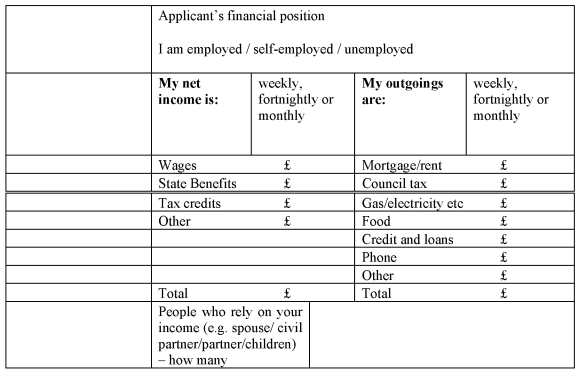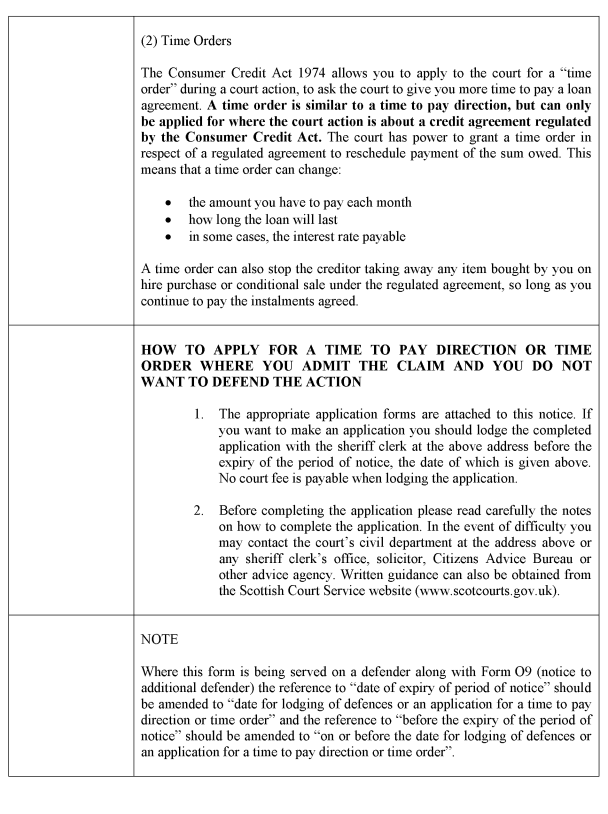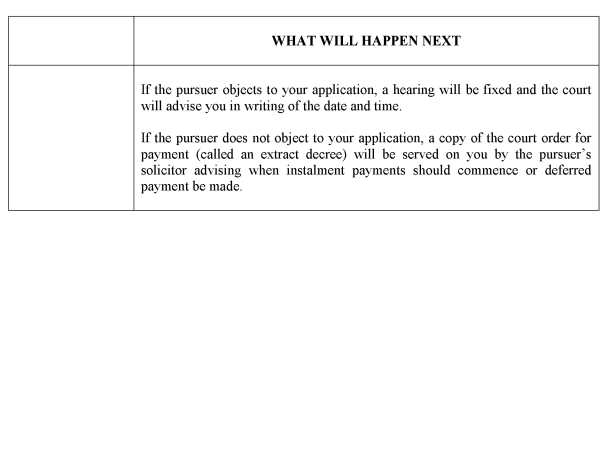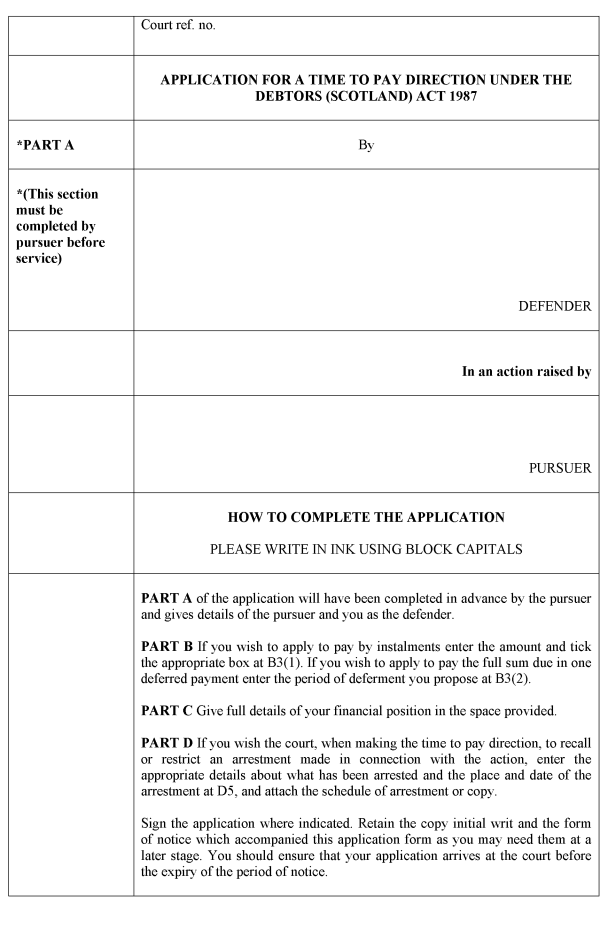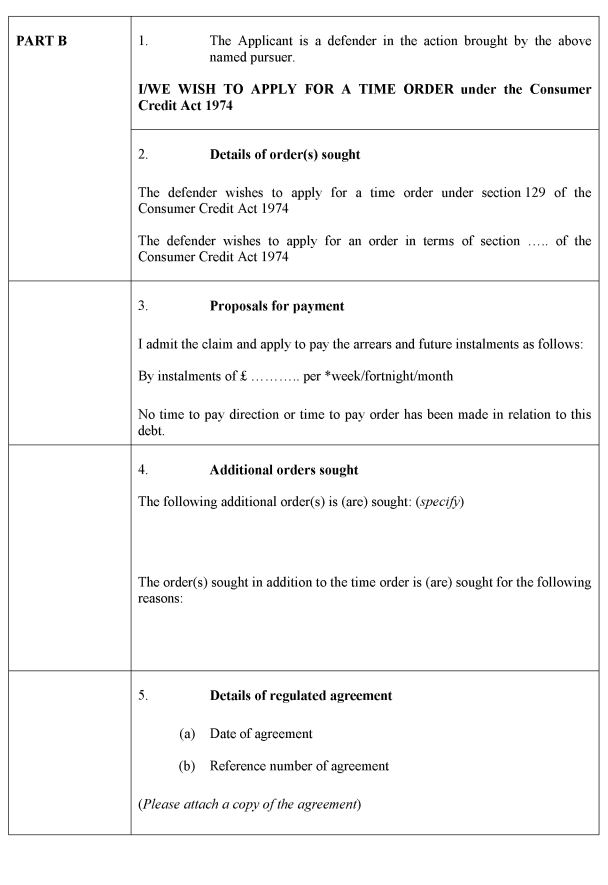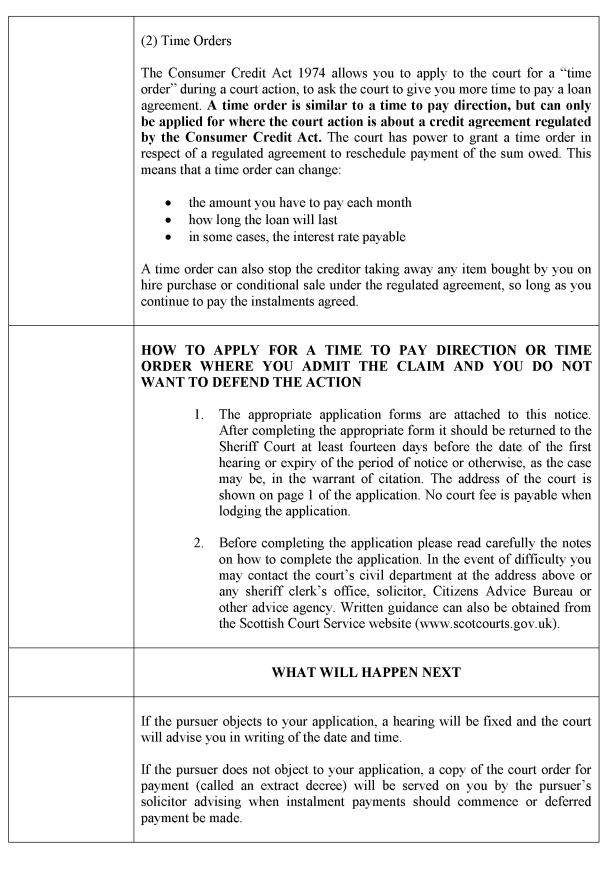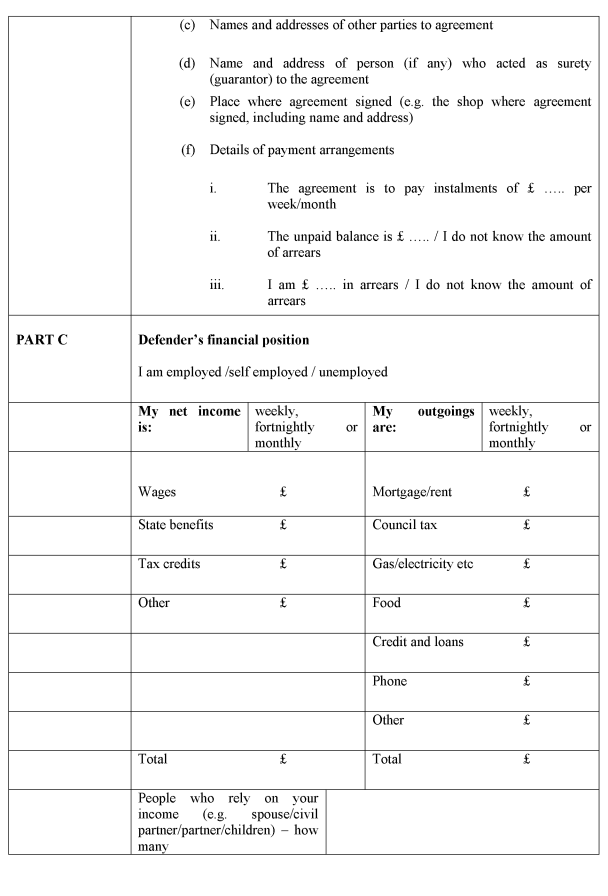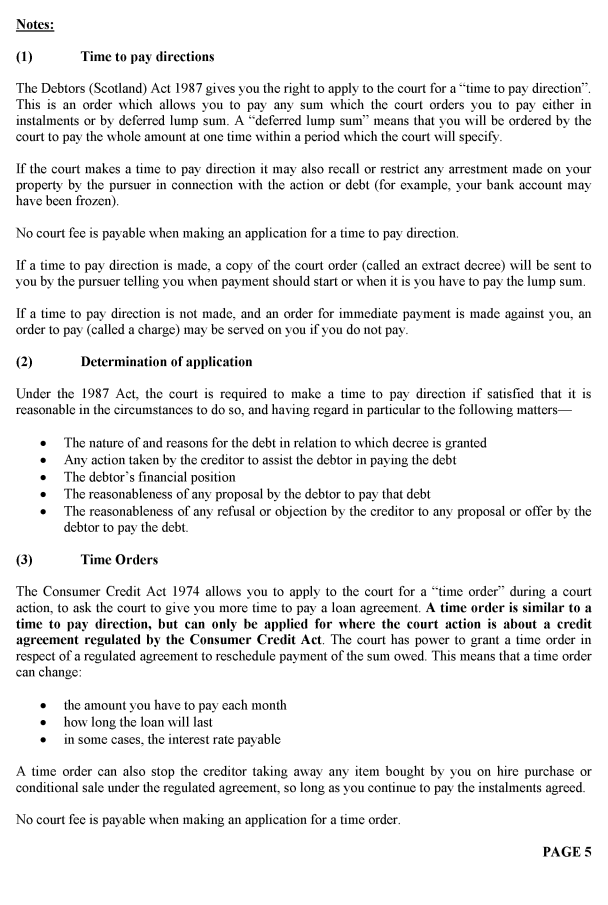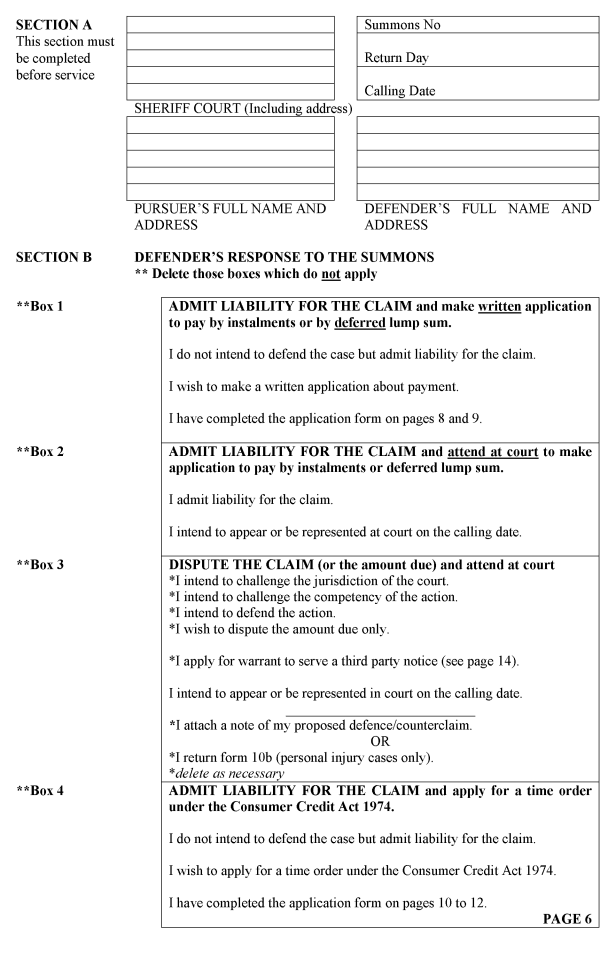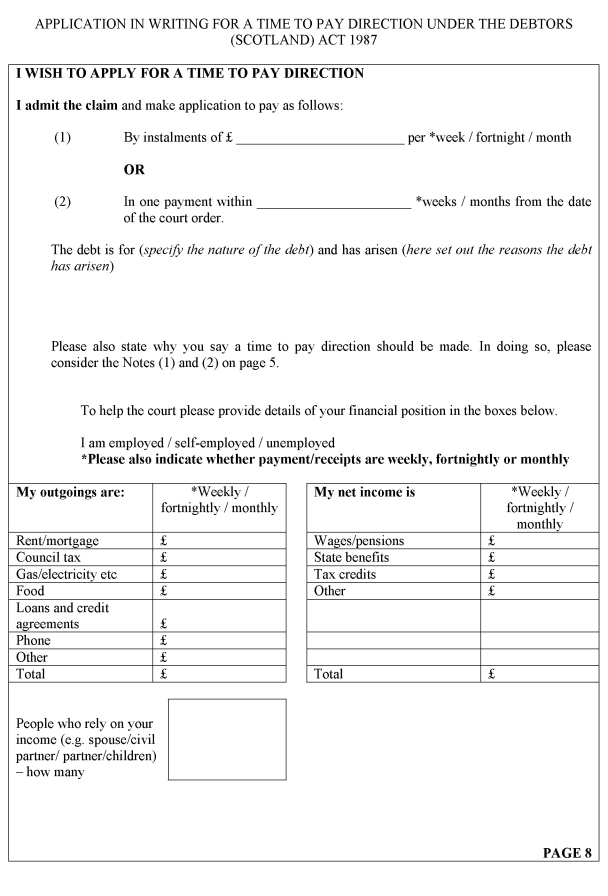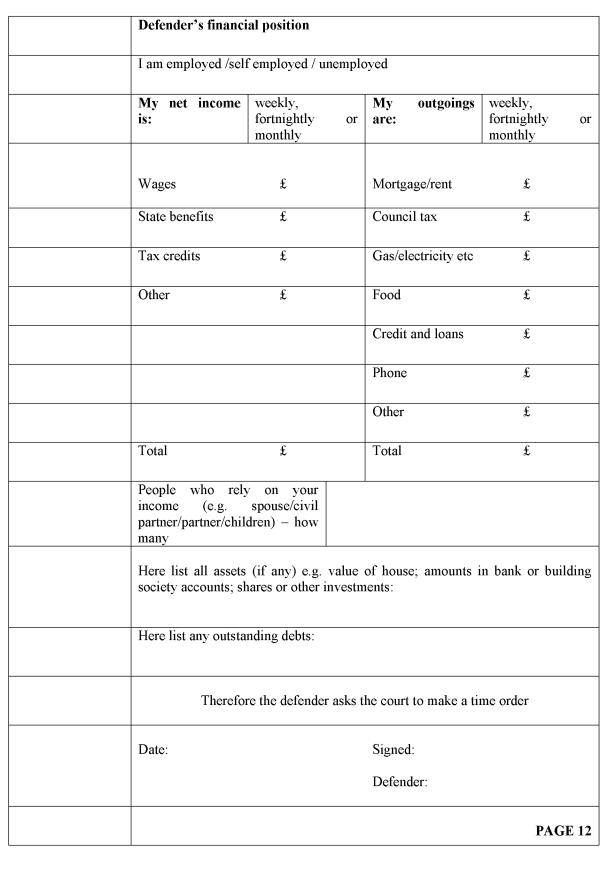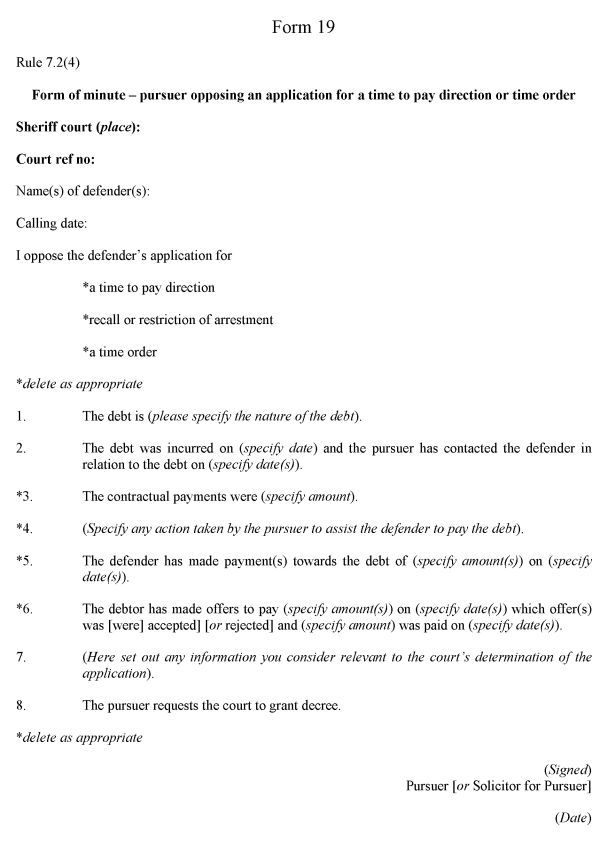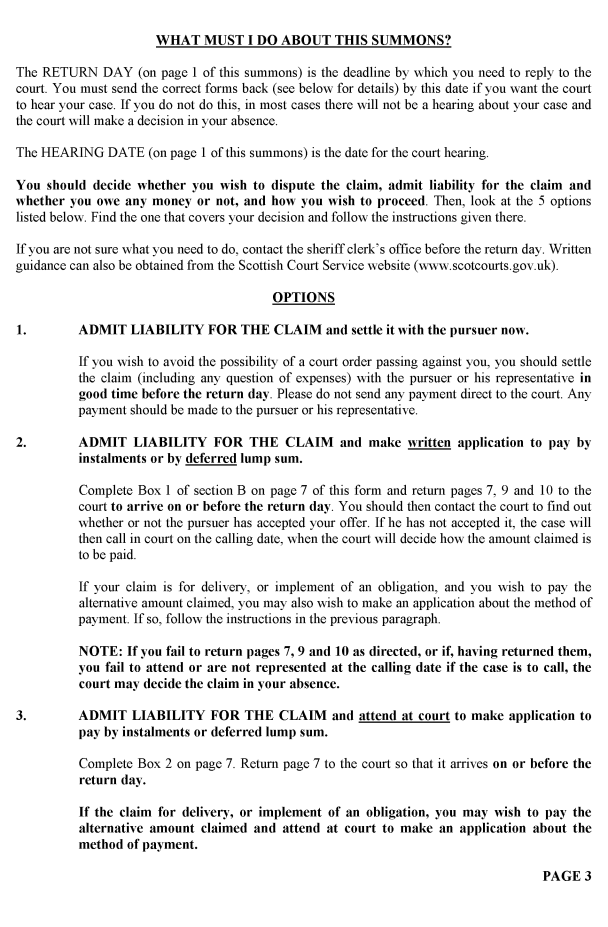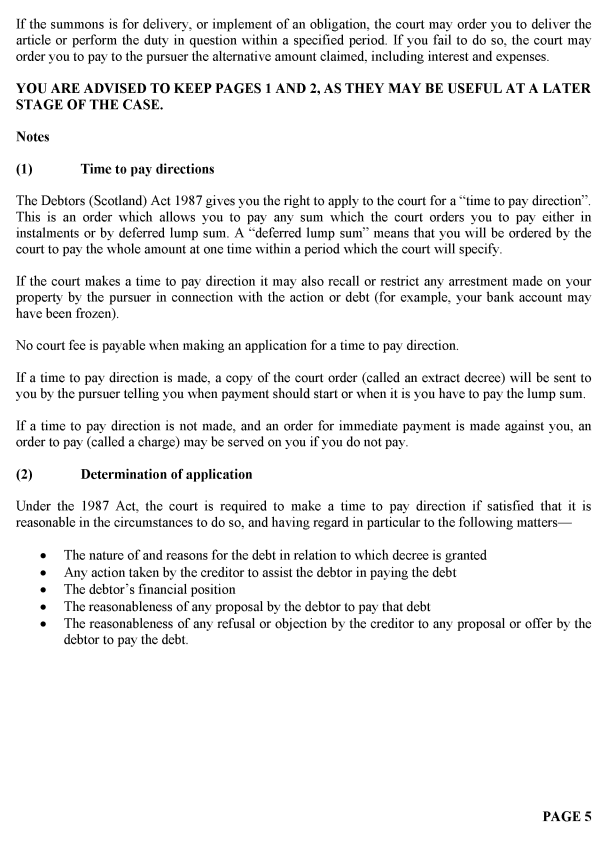- Latest available (Revised)
- Original (As made)
Act of Sederunt (Sheriff Court Rules) (Miscellaneous Amendments) 2009
You are here:
- Scottish Statutory Instruments
- 2009 No. 294
- Whole Instrument
- Previous
- Next
More Resources
Status:
This is the original version (as it was originally made). This item of legislation is currently only available in its original format.
Scottish Statutory Instruments
2009 No. 294
Sheriff Court
Act of Sederunt (Sheriff Court Rules) (Miscellaneous Amendments) 2009
Made
18th August 2009
Coming into force in accordance with paragraph 1(1) and (2)
The Lords of Council and Session, under and by virtue of the powers conferred by section 32 of the Sheriff Courts (Scotland) Act 1971(1) and of all other powers enabling them in that behalf, having approved draft rules submitted to them by the Sheriff Court Rules Council in accordance with section 34 of the said Act of 1971, do hereby enact and declare:
Citation, commencement and interpretation
1.—(1) This Act of Sederunt may be cited as the Act of Sederunt (Sheriff Court Rules) (Miscellaneous Amendments) 2009 and, subject to subparagraph (2), comes into force on 1st October 2009.
(2) Paragraphs 2 to 7 come into force on 1st December 2009.
(3) This Act of Sederunt is to be inserted in the Books of Sederunt.
(4) In this Act of Sederunt—
“the 1988 Rules” means the Act of Sederunt (Proceedings in the Sheriff Court under the Debtors (Scotland) Act 1987) 1988(2);
“the Ordinary Cause Rules” means the Ordinary Cause Rules in Schedule 1 to the Sheriff Courts (Scotland) Act 1907(3);
“the Summary Application Rules” means the Act of Sederunt (Summary Applications, Statutory Applications and Appeals etc. Rules) 1999(4);
“the Summary Cause Rules” means the Summary Cause Rules in Schedule 1 to the Act of Sederunt (Summary Cause Rules) 2002(5); and
“the Small Claim Rules” means the Small Claim Rules in Schedule 1 to the Act of Sederunt (Small Claim Rules) 2002(6).
Time to pay directions and time orders
2.—(1) The Ordinary Cause Rules are amended in accordance with the following subparagraphs.
(2) After rule 3.2 (actions relating to heritable property) insert—
“Actions relating to regulated agreements
3.2A. In an action which relates to a regulated agreement within the meaning given by section 189(1) of the Consumer Credit Act 1974(7)—
(a)the initial writ shall include an averment that such an agreement exists and details of that agreement; and
(b)a copy of the regulated agreement shall be attached to the initial writ.”.
(3) In rule 7.3 (applications for time to pay directions or time orders in undefended causes)—
(a)after paragraph (2) insert—
“(2A) As soon as possible after the application of the defender is lodged, the sheriff clerk shall send a copy of it to the pursuer by first class ordinary post.”; and
(b)for paragraph (4) substitute—
“(4) Where the pursuer objects to the application of the defender made in accordance with paragraph (2) he shall on the same date—
(a)complete and lodge with the sheriff clerk Form O3A;
(b)minute for decree in accordance with rule 7.2; and
(c)send a copy of Form O3A to the defender.
(4A) The sheriff clerk shall then fix a hearing on the application of the defender and intimate the hearing to the pursuer and the defender.
(4B) The hearing must be fixed for a date within 28 days of the date on which the Form O3A and the minute for decree are lodged.”.
(4) In the Schedule, for Form O3 (form of citation where application for time to pay direction and time order may be made) substitute the forms set out in Schedule 1 to this Act of Sederunt.
3.—(1) The Summary Application Rules are amended in accordance with the following subparagraphs.
(2) In rule 2.4 (the initial writ)(8), after paragraph (4) insert—
“(4A) In an action which relates to a regulated agreement within the meaning given by section 189(1) of the Consumer Credit Act 1974—
(a)the initial writ shall include an averment that such an agreement exists and details of the agreement; and
(b)a copy of the regulated agreement shall be lodged with the initial writ.”.
(3) In rule 2.22 (applications for time to pay directions or time orders)—
(a)in paragraph (2)(b) for “seven” substitute “14”;
(b)for paragraph (3) substitute—
“(3) On lodging an application under paragraph (2)(b), the defender shall send a copy of it to the pursuer by first class ordinary post.
(4) Where the pursuer objects to the application of the defender lodged under paragraph (2)(b) he shall—
(a)complete and lodge with the sheriff clerk Form 5A prior to the date fixed for the hearing of the summary application; and
(b)send a copy of that form to the defender.
(5) The sheriff clerk shall then fix a hearing in relation to the application under paragraph (2)(b) and intimate the hearing to the pursuer and the defender.
(6) The sheriff may determine an application under paragraph (2)(c) without the defender having to appear.”.
(4) In Form 4 in the Schedule (form of warrant of citation etc.), in paragraph (b), for “seven” substitute “fourteen”.
(5) For Form 5 in the Schedule (form of notice etc.), substitute the forms set out in Schedule 2 to this Act of Sederunt.
4.—(1) The Summary Cause Rules are amended in accordance with the following subparagraphs.
(2) After rule 4.2 (statement of claim) insert—
“Actions relating to regulated agreements
4.2A. In an action which relates to a regulated agreement within the meaning given by section 189(1) of the Consumer Credit Act 1974—
(a)the statement of claim shall include an averment that such an agreement exists and details of the agreement; and
(b)a copy of the regulated agreement shall be attached to the summons.”.
(3) In rule 7.2 (application for time to pay direction or time order)—
(a)after paragraph (1) insert—
“(1A) The sheriff clerk must on receipt forthwith intimate to the pursuer a copy of any response lodged under paragraph (1).”;
(b)in paragraph (2), for “two days” substitute “9 days”; and
(c)for paragraph (4) substitute—
“(4) If the pursuer wishes to oppose the application for a time to pay direction or time order made in accordance with paragraph (1)(a) he must before the time the sheriff clerk’s office closes for business on the day occurring 9 days before the calling date—
(a)lodge a minute in Form 19; and
(b)send a copy of that minute to the defender.”.
(4) For Form 1a (summons) in Appendix 1 substitute the form set out in Schedule 3 to this Act of Sederunt.
(5) For Form 19 (form of minute) in Appendix 1 substitute the form set out in Schedule 4 to this Act of Sederunt.
5.—(1) The Small Claim Rules are amended in accordance with the following subparagraphs.
(2) After rule 4.2 (statement of claim) insert—
“Actions relating to regulated agreements
4.2A. In an action which relates to a regulated agreement within the meaning given by section 189(1) of the Consumer Credit Act 1974—
(a)the statement of claim shall include an averment that such an agreement exists and details of the agreement; and
(b)a copy of the regulated agreement shall be attached to the summons.”.
(3) In rule 8.2 (application for time to pay direction or time order)—
(a)after paragraph (1) insert—
“(1A) The sheriff clerk must on receipt forthwith intimate to the pursuer a copy of any response lodged under paragraph (1).”;
(b)in paragraph (2) for “two days” substitute “9 days”; and
(c)for paragraph (4) substitute—
“(4) If the pursuer wishes to oppose the application for a time to pay direction or time order made in accordance with paragraph (1)(a) he must before the time the sheriff clerk’s office closes for business on the day occurring 9 days before the hearing date—
(a)lodge a minute in Form 13; and
(b)send a copy of that minute to the defender.”.
(4) For Form 1a in Appendix 1 (summons) substitute the form set out in Schedule 5 to this Act of Sederunt.
(5) For Form 13 in Appendix 1 (form of minute) substitute the form set out in Schedule 6 to this Act of Sederunt.
6. But the Ordinary Cause Rules, Summary Application Rules, Summary Cause Rules and Small Claim Rules as they applied immediately before 1st December 2009 continue to have effect for the purpose of any application for a time to pay direction or a time order made in connection with an initial writ or summons, as the case may be, lodged before that date.
Return, calling and hearing dates
7.—(1) In rule 4.5(7) of the Summary Cause Rules (period of notice), for “seven days” substitute “14 days”.
(2) In rule 9.1(3) of the Small Claim Rules (the hearing), for “seven days” substitute “14 days”.
(3) But rule 4.5(7) of the Summary Cause Rules and rule 9.1(3) of the Small Claim Rules as they applied immediately before 1st December 2009 continue to have effect for the purpose of any summons lodged before that date.
Applications for time to pay orders
8.—(1) The 1988 Rules are amended in accordance with subparagraph (2).
(2) In Form 2 in the Schedule(9), for the section beginning “The applicant’s financial position is:-” substitute the following section—
(3) But the 1988 Rules as they applied immediately before 1st October 2009 continue to have effect for the purpose of any application for a time to pay order made before that date.
Conjoined arrestment orders
9.—(1) The 1988 Rules are amended in accordance with the following subparagraphs.
(2) In Form 43 in the Schedule (application for a conjoined arrestment order)(10)—
(a)in paragraph 1, after the entry for “The employer” insert—
“Debtor’s place of employment : (address)”;
(b)before the paragraph beginning “The applicant asks the court” insert—
“8. A debt advice and information package was provided to the debtor on (insert date).”.
(3) In Form 45 in the Schedule (conjoined arrestment order)(11)—
(a)in the section beginning “SPECIFIES”—
(i)for “Current maintenance” substitute “Current maintenance debt”; and
(ii)for “Daily rate” substitute “Daily rate recoverable”;
(b)for the last sentence of paragraph 5 of the “instructions to employer” substitute—
“If the debtor ceases to be employed by the employer, the employer must, as soon as is reasonably practicable, notify the sheriff clerk of that fact and, so far as is known to him, of the name and address of any new employer of the debtor.”.
(4) In Form 46 in the Schedule (notice of service of conjoined arrestment order), for the last sentence of the first paragraph substitute—
“If the debtor ceases to be employed by the employer, the employer must, as soon as is reasonably practicable, notify the sheriff clerk of that fact and, so far as is known to him, of the name and address of any new employer of the debtor.”.
(5) In Form 51 in the Schedule (notice of service of an order varying a conjoined arrestment order), for the last sentence substitute—
“If the debtor ceases to be employed by the employer, the employer must, as soon as is reasonably practicable, notify the sheriff clerk of that fact and, so far as is known to him, of the name and address of any new employer of the debtor.”.
Other minor amendments – diligence
10.—(1) The Ordinary Cause Rules are amended in accordance with the following subparagraphs.
(2) In rule 19.2 (warrants for diligence on counterclaims)(12)—
(a)in paragraph (1), for “arrestment on the dependence” substitute “interim diligence”; and
(b)omit paragraphs (2) to (4).
(3) In rule 20.3 (warrants for diligence on third party notice)—
(a)for paragraph (1) substitute—
“(1) A defender who applies for an order for service of a third party notice may apply for—
(a)a warrant for arrestment to found jurisdiction;
(b)a warrant for interim diligence,
which would have been permitted had the warrant been sought in an initial writ in a separate action.”;
(b)in paragraph (2), for “such a warrant” substitute “a warrant under paragraph (1)(a)”; and
(c)in paragraph (3), for “paragraph (1)” substitute “paragraph (1)(a)”.
11.—(1) The Summary Cause Rules are amended in accordance with the following subparagraphs.
(2) In rule 4.4(4) (authentication and effect of summons)(13), omit the words “on the dependence, or”.
(3) In rule 5.5 (service on persons whose address is unknown), at the beginning insert—
“(A1) Subject to rule 6.A7, this rule applies to service where the address of a person is not known.”.
(4) In rule 5.6 (service by post)(14), omit paragraph (A1).
(5) In rule 10.1 (counterclaim)(15)—
(a)in paragraph (3), for the words from “warrant” to “counterclaim” substitute “warrant for interim diligence in respect of a counterclaim”; and
(b)omit paragraph (4), (4A), (4B) and (5).
(6) In rule 11.3 (warrants for diligence on third party notice)(16)—
(a)for paragraph (1) substitute—
“(1) A defender who applies for an order for service of a third party notice may apply for—
(a)a warrant for arrestment to found jurisdiction;
(b)a warrant for interim diligence,
which would have been permitted had the warrant been sought in an initial writ in a separate action.”; and
(b)in paragraph (1A), for “paragraph (1)” substitute “paragraph (1)(a)”.
12.—(1) The Small Claim Rules are amended in accordance with the following subparagraphs.
(2) In rule 4.4(4) (authentication and effect of summons)(17), omit the words “on the dependence, or”.
(3) In rule 11.3 (counterclaim)(18), omit paragraph (3).
13. In rule 69E of the 1988 Rules (application for release of property where arrestment unduly harsh)(19), in paragraph (2)(a), omit the words “of the Act”.
Dismissal of actions due to delay
14. After rule 15.6 of the Ordinary Cause Rules (motions to sist)(20) insert—
“Dismissal of action due to delay
15.7.—(1) Any party to an action may, while that action is depending before the court, apply by written motion for the court to dismiss the action due to inordinate and inexcusable delay by another party or another party’s agent in progressing the action, resulting in unfairness.
(2) A motion under paragraph (1) shall—
(a)include a statement of the grounds on which it is proposed that the motion should be allowed or as the case may be; and
(b)be lodged in accordance with rule 15.1.
(3) A notice of opposition to the motion in Form G9 shall include a statement of the grounds of opposition to the motion.
(4) In determining an application made under this rule, the court may dismiss the action if it appears to the court that—
(a)there has been an inordinate and inexcusable delay on the part of any party or any party’s agent in progressing the action; and
(b)such delay results in unfairness specific to the factual circumstances, including the procedural circumstances, of that action.
(5) In determining whether or not to dismiss an action under paragraph (4), the court shall take account of the procedural consequences, both for the parties and for the work of the court, of allowing the action to proceed.”.
15. After Chapter 22 of the Summary Cause Rules (decree by default) insert—
“CHAPTER 22ADISMISSAL OF ACTION DUE TO DELAY
Dismissal of action due to delay
22A.1.—(1) Any party to an action may, while that action is depending before the court, apply by written incidental application to the court to dismiss the action due to inordinate and inexcusable delay by another party or another party’s agent in progressing the action, resulting in unfairness.
(2) An application under paragraph (1) shall include a statement of the grounds on which it is proposed that the application should be allowed or as the case may be.
(3) In determining an application made under this rule, the court may dismiss the action if it appears to the court that—
(a)there has been an inordinate and inexcusable delay on the part of any party or any party’s agent in progressing the action; and
(b)such delay results in unfairness specific to the factual circumstances, including the procedural circumstances, of that action.
(4) In determining whether or not to dismiss an action under paragraph (3), the court shall take account of the procedural consequences, both for the parties and for the work of the court, of allowing the action to proceed.
(5) Rule 9.1 shall, with the necessary modifications, apply to an application under paragraph (1).”.
Insolvency or death of cautioner or guarantor
16. In rule 27.8 (insolvency or death of cautioner or guarantor) of the Ordinary Cause Rules, in paragraph (d)(i), for “administration or winding up order” substitute “administration, bank administration or building society special administration order or a winding up, bank insolvency or building society insolvency order”.
Definition of “Her Majesty’s Forces”
17. In rule 2.1 (interpretation) of the Act of Sederunt (Child Care and Maintenance Rules) 1997(21), for the definition of “Her Majesty’s Forces” substitute—
““Her Majesty’s Forces” means the regular forces as defined in section 374 of the Armed Forces Act 2006(22); and”.
Counter-Terrorism Act 2008: foreign travel restriction orders
18. After Part XXXVII (Employment Tribunals Act 1996) of the Summary Application Rules(23), insert—
“PART XXXVIIICounter-Terrorism Act 2008
Variation, renewal or discharge of foreign travel restriction order
3.38.—(1) Where an application under paragraph 9 of Schedule 5 to the Counter-Terrorism Act 2008(24) for an order varying, renewing or discharging a foreign travel restriction order is made in a sheriff court other than the sheriff court in which the process relating to the foreign travel restriction order is held—
(a)the initial writ containing the application shall contain averments as to the sheriff court in which the process relating to the foreign travel restriction order is held;
(b)the sheriff clerk with whom the application is lodged shall notify the sheriff clerk of the sheriff court in which the process relating to the foreign travel restriction order is held; and
(c)the sheriff clerk of the sheriff court in which the process relating to the foreign travel restriction order is held shall, not later than 4 days after receipt of such notification, transfer the process relating to the foreign travel restriction order to the sheriff clerk of the sheriff court in which the application is made.
(2) For the purposes of paragraph (1), the sheriff court in which the process relating to the order is held is the sheriff court in which the foreign travel restriction order was granted or, where the process has been transferred under that paragraph, the last sheriff court to which the process has been transferred.
(3) A failure of the sheriff clerk to comply with paragraph (1) shall not invalidate the application.”.
A.C. HAMILTON
Lord President
I.P.D.
Edinburgh
18th August 2009
Paragraph 2(4)
SCHEDULE 1
Paragraph 3(5)
SCHEDULE 2
Paragraph 4(4)
SCHEDULE 3
Rule 4.3(a)
Paragraph 4(5)
SCHEDULE 4
Paragraph 5(4)
SCHEDULE 5
Rule 4.3(a)
Paragraph 5(5)
SCHEDULE 6
Rule 8.2(4)
EXPLANATORY NOTE
(This note is not part of the Act of Sederunt)
This Act of Sederunt makes various amendments to the Ordinary Cause Rules, the Summary Application Rules, the Summary Cause Rules, the Small Claim Rules and the 1988 Rules.
Paragraphs 2 to 6 amend the rules in relation to applications for time to pay directions and time orders by:
(a)inserting a new rule 3.2A into the Ordinary Cause Rules which requires, in actions relating to regulated agreements under the Consumer Credit Act 1974, that the initial writ includes a specific averment that such an agreement exists and details of the agreement (paragraph 2(2));
(b)providing in the Ordinary Cause Rules and Summary Application Rules for intimation of a copy of an application for a time to pay direction or time order to the pursuer and for a form of response where the pursuer applies for a time to pay direction or a time order (paragraphs 2(3) and 3(3));
(c)providing in each set of Rules for separate forms of application for time to pay directions and time orders (paragraphs 2(4), 3(3), 4(4) and 5(4);
(d)amending rule 2.22(2) of the Summary Application Rules to increase the period for lodging an application for a time to pay direction or time order from 7 to 14 days before the diet fixed for the hearing of the summary application or the expiry of the period of notice (paragraph 3(3));
(e)inserting new provision into the Summary Cause Rules and Small Claim Rules to require the sheriff clerk to intimate a copy of an application for a time to pay direction or time order to the pursuer and to increase the period for the pursuer lodging his response to such an application from 2 to 9 days before the calling date (paragraphs 4(3) and 5(3));
(f)substituting in the Summary Cause Rules and Small Claim Rules new forms 1a (summons) providing more detailed guidance in the defender’s copy summons in relation to applying for time to pay directions and time orders (paragraphs 4(4) and 5(4));
(g)substituting in the Summary Cause and Small Claim Rules a new form of minute for a pursuer opposing an application for a time to pay direction or a time order (paragraphs 4(5) and 5(5)).
Paragraph 7 amends the period between the return day and calling date in summary cause actions and between the return day and hearing date in small claim actions from 7 to 14 days.
Paragraph 8 updates Form 2 in the 1988 Rules (form of application for a time to pay order).
Paragraph 9(2) amends Form 43 in those Rules (application for a conjoined arrestment order) to provide for details of the debtor’s place of employment to be given and for an averment that the debtor was given a debt advice and information package. Paragraph 9(3) to (5) amends Forms 45 (conjoined arrestment order), 46 (notice of service of conjoined arrestment order) and 51 (notice of service of an order varying a conjoined arrestment order) to provide instructions to the employer to notify the sheriff clerk if the debtor ceases to be employed by him and to provide details of the new employer, if known.
Paragraphs 10 to 13 make other minor amendments to the Ordinary Cause, Summary Cause, Small Claim Rules and the 1988 Rules.
Paragraphs 14 and 15 insert rules into the Ordinary Cause Rules and the Summary Cause Rules setting out procedure for the dismissal of actions due to delay on the part of another party in progressing the action. Such applications are made by motion in actions proceeding under the Ordinary Cause Rules and by incidental application in actions proceeding under the Summary Cause Rules. Provision is made for the other party to lodge a notice of opposition to the motion or application. The court may dismiss the action if it considers that the delay has been inordinate or inexcusable and has resulted in unfairness.
Paragraph 16 amends a rule in the Ordinary Cause Rules regarding the insolvency or death of a cautioner or guarantor, to reflect the introduction of powers under the Banking Act 2009 to obtain orders in respect of failing banks or building societies.
Paragraph 17 amends the definition of “Her Majesty’s Forces” in Chapter 2 of the Child Care and Maintenance Rules 1997 in consequence of the Armed Forces Act 2006.
Paragraph 18 inserts a new Part XXXVIII into Chapter 3 of the Summary Application Rules. This new Part provides a new rule 3.38 relating to applications to the sheriff for variation, renewal or recall of foreign travel restriction orders under Schedule 5 of the Counter-Terrorism Act 2008.
1971 c.58; section 32 was amended by the Law Reform (Miscellaneous Provisions) (Scotland) Act 1985 (c.73), Schedule 2, paragraph 12, the Civil Evidence (Scotland) Act 1988 (c.32), section 2(4), the Children (Scotland) Act 1995 (c.36), Schedule 4, paragraph 18(2), the Adults with Incapacity (Scotland) Act 2000 (asp 4), Schedule 5, paragraph 13 and the Debt Arrangement and Attachment (Scotland) Act 2002 (asp 17), section 43, and was extended by the Child Support Act 1991 (c.48), sections 39(2) and 49, the Vulnerable Witnesses (Scotland) Act 2004 (asp 3), section 14(2) and the Bankruptcy and Diligence etc. (Scotland) Act 2007 (asp 3), section 33.
S.I. 1988/2013, amended by S.I. 1991/1920, 1993/920, 1994/3086, 1995/1876, 1996/2709, 1999/1820 and S.S.I. 2002/560 and 2008/121.
1907 c.51. Schedule 1 was substituted by S.I. 1993/1956 and amended by S.I. 1996/2167 and 2445, S.S.I. 2000/239 and 408, 2001/8 and 144, 2002/7, 128 and 560, 2003/25 and 26, 2004/197 and 350, 2005/20, 189, 638 and 648 and 2006/198 and 207, 293, 410 and 509, 2007/6, 339, 440 and 463, 2008/121, 223 and 365 and 2009/107, 164, 284 and 285.
S.S.I. 1999/929, amended by S.S.I. 2000/18 and 387, 2001/142, 2002/7, 129, 130, 146 and 563, 2003/26, 98, 261, 319, 346 and 556, 2004/197, 222, 334 and 455, 2005/61, 473, 504 and 648, 2006/198, 410, 437 and 509, 2007/6, 233, 339, 440 and 463, 2008/9, 41, 111, 223, 335 and 365 and 2009/107.
S.S.I. 2002/132, amended by S.S.I. 2002/516, 2003/26, 2004/197, 2005/648, 2006/509, 2007/6, 339, 440 and 463, 2008/121, 223 and 365 and 2009/107.
S.S.I. 2002/133, amended by S.S.I. 2003/26 and 601, 2004/197, 2005/648, 2006/509, 2007/6, 339, 440 and 463, 2008/121, 223 and 365 and 2009/107.
Rule 2.4 was amended by S.S.I. 2004/197.
Form 2 was amended by S.S.I. 2002/560 and 2008/121.
Form 43 was amended by S.S.I. 2002/560.
Form 45 was amended by S.I. 1993/920 and S.S.I. 2008/121.
Rule 19.2 was amended by S.I. 1996/2445 and S.S.I. 2004/197.
Rule 4.4(4) was inserted by S.S.I. 2004/197.
Rule 5.6(A1) was inserted by S.S.I. 2008/121.
Rule 10.1 was amended by S.S.I. 2004/197.
Rule 11.3 was amended by S.S.I. 2004/197.
Rule 4.4(4) was inserted by S.S.I. 2004/197.
Rule 11.1 was amended by S.S.I. 2004/197.
Rule 69E was inserted by S.S.I. 2009.107.
Rule 15.6 was inserted by S.S.I. 2000/239.
S.S.I. 1997/291. Rule 2.1 was amended by S.S.I. 2006/411.
Part XXXVII was inserted by S.S.I. 2009/109.
Options/Help
Print Options
PrintThe Whole Instrument
Legislation is available in different versions:
Latest Available (revised):The latest available updated version of the legislation incorporating changes made by subsequent legislation and applied by our editorial team. Changes we have not yet applied to the text, can be found in the ‘Changes to Legislation’ area.
Original (As Enacted or Made): The original version of the legislation as it stood when it was enacted or made. No changes have been applied to the text.
More Resources
Access essential accompanying documents and information for this legislation item from this tab. Dependent on the legislation item being viewed this may include:
- the original print PDF of the as enacted version that was used for the print copy
- lists of changes made by and/or affecting this legislation item
- confers power and blanket amendment details
- all formats of all associated documents
- correction slips
- links to related legislation and further information resources
More Resources
Use this menu to access essential accompanying documents and information for this legislation item. Dependent on the legislation item being viewed this may include:
- the original print PDF of the as made version that was used for the print copy
- correction slips
Click 'View More' or select 'More Resources' tab for additional information including:
- lists of changes made by and/or affecting this legislation item
- confers power and blanket amendment details
- all formats of all associated documents
- links to related legislation and further information resources
